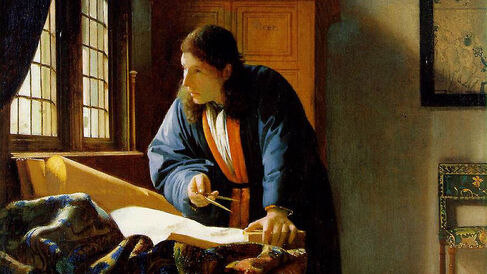A Dutch Pioneer: Antoni van Leeuwenhoek

Antoni van Leeuwenhoek was a Dutch cloth merchant by trade, and one of the first microscopists. He examined a wide variety of objects with his microscope - from bees to exploding gunpowder. He was probably the first person to observe and describe bacteria.
Early microscopists seized on frogs as objects of study both for their anatomical similarity to humans and their translucent skin. But without the benefits of electric lighting, 18th-century microscopes struggled to adequately illuminate their subjects. George Adams and Johann Nathanael Lieberkühn devised solutions to practical problems of vivisection, including of illumination, with their tables for displaying 'prepared,' living frog specimens. Technical advances of this kind facilitated new ways of seeing and understanding frogs' bodies.
Antoni van Leeuwenhoek
Antoni van Leeuwenhoek (1632-1723) was born in Delft, where he lived for most of his life. Leeuwenhoek attended a grammar school and was taught by his uncle before taking up an apprenticeship with an Amsterdam linen-draper. His first encounter with microscopy would have been examining cloth samples with a magnifying glass.
With his home-made microscopes he observed a wide variety of different objects. A friend of his, Dr. Regnerus de Graaf, introduced Leeuwnhoek's first observations to the Royal Society of London in 1673:
"Mr Leewenhoeck [sic] hath lately contrived Microscopes excelling those that have hitherto been made by Eustachio Divini and others; adding that he hath given a specimen of their excellency by divers Observations, and is ready to receive difficult tasks for more, if the Curious here shall please to send him such." (1)
His observations in this first communication were of mould on the skin, the sting of a bee, the head of a bee, the eye of a bee, and a louse. During his lifetime he sent 190 papers to the Royal Society, and was elected a Fellow in 1680. He kept the method of making his microscopes secret and there was much interest and speculation into their construction. Throughout Europe there was also a great deal of interest in his observations. Many people travelled to his house to see his results first hand.
An early hands-on science centre?
Adapted from L. C. Taub, 'Heroes of microscopy and museology', Studies in History and Philosophy of Science 30, 4 (1999), 729-44.
Leeuwenhoek said that he had killed more than a hundred mosquitoes over the course of several days, in an attempt to display the mouth parts for others to see. He used a range of techniques for fixing and viewing specimens under the lens. In some cases he simply glued solid objects to the pins that held them in front of the lens. Other specimens (such as gold, insect muscle fibres and spermatozoa) were dried onto mica or pieces of glass and were then fixed to pins. Fluids, including blood, were held in fine glass tubes, which he set in front of the lens. To show the circulation of blood, he designed special microscopes to view small eels, which he sometimes had available for visitors.
Just as with the early telescope, there were some difficulties in persuading people that the microscope could be used reliably. Not everyone was instantly able to use the microscope on their own; practice was required. Leeuwenhoek was remarkable in providing opportunities for others to engage in observations. In his home he set up a sort of hands-on interactive science centre, so that visitors could come and use microscopes to examine specimens he had collected, prepared, and put on display.
Early on Leeuwenhoek had fixed the more striking of his specimens to separate microscopes, in anticipation of receiving visitors; by 1676 he could offer fifty different images of wood alone. He continued to add to and replace these preparations up until his very last years, constructing new microscopes specifically for that purpose; by 1700 he had hundreds of instruments. When his collection of 248 microscopes was auctioned in 1747, there were 167 of them that still had an intact object set up for viewing.
References
- R. de Graaf, 'A specimen of some observations made by a microscope ...', Philosophical Transactions, vol. 8 (1673), 6037-6038, p. 6037.
James Hyslop & Liba Taub
James Hyslop & Liba Taub, 'A Dutch pioneer: Antoni van Leeuwenhoek', Explore Whipple Collections, Whipple Museum of the History of Science, University of Cambridge, 2008.
